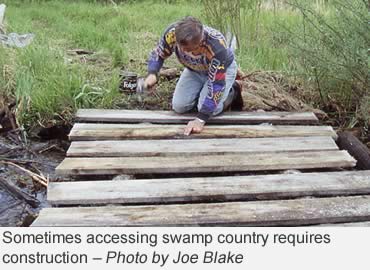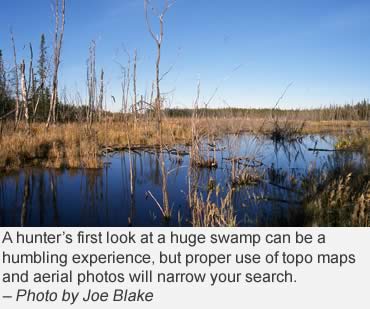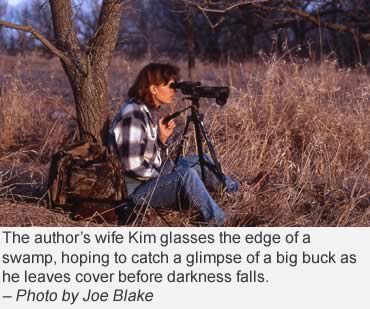Because trophy bucks absolutely love the solitude and security of a swamp.
It hadn’t rained at all, but the foggy afternoon mist hung so thick around me that water clung to every branch, every blade of grass and every inch of this bowhunter’s body!
The thick stand of poplars took on a surreal look as every nook and cranny faded into that dreary gray, washed-out landscape. As I scanned the dense line of willows that marked the edge of the giant swamp, I caught myself wishing for darkness so I could slip out of this hell hole. What I saw next caused my heart to skip a beat.
Standing like statues just inside the impenetrable willows were two giant white-tailed bucks, both staring intently past my ambush toward the picked cornfield where several deer had already begun feeding. How the bucks had arrived at this spot undetected astonished me. They were only about 15 yards away wearing matching socks of heavy, wet mud well past their knees!
These trophy whitetails apparently bedded somewhere out in the center of this vast morass and were in no hurry to leave the safety of its confines before total darkness. All thoughts of warming up vanished as I slowly eased my longbow from its resting spot … The next move belonged to the deer.
For many long minutes, the bucks seemed frozen in time, standing stock-still at close range but barely visible through the 15 yards of soup to the densely woven clump of willows where they held their ground. That both deer were shooters was not in question. I couldn’t begin to count points given the situation, but even though they were well within range, I had no shot.
At one point, I considered grunting softly to try to spur some action, but abandoned the idea because I knew that at such close range both bucks would pinpoint me and the game would be over. Now, with darkness closing fast and few options open, I looked down for a split second to check the water pouring down the limbs and riser of my longbow, across the fingers of my shooting glove, and also matting my feathers tightly to the cedar shaft nocked to my bowstring. Getting off an accurate shot, even at close range, would be difficult!
Not that it mattered. For when I looked back toward the bucks, they had vanished! No sound, no movement … Maybe I had imagined it all, but the muddy trail leading into the depths of the huge swamp told the story. A pair of swamp bucks had outsmarted me again.
 Wherever whitetails are, there are hunters who pursue them with passion and conviction like few other trophies. A big buck is often described as a separate species in that its habits and behavior differs significantly from other whitetails, making it seemingly impossible to kill at times.
Wherever whitetails are, there are hunters who pursue them with passion and conviction like few other trophies. A big buck is often described as a separate species in that its habits and behavior differs significantly from other whitetails, making it seemingly impossible to kill at times.
The common denominator, though, wherever they call home, is that trophy bucks absolutely love the solitude and security of a swamp. From the vast tamarack swamps in the North to cattail and willow swamps in mid-America to the brackish tidal swamps of the South, white-tailed bucks grow old by sticking like glue to the heavy cover in and around swamp country. Hunting these areas is difficult, but not impossible.
Finding a Swamp
To find a swamp, drive roads in your area or study local topo maps. These maps will show low ground clearly and these areas should be circled and checked out on foot. One beauty of swamp hunting is that it is often open to the public because the ground isn’t useable for farming or development. In my home state of Minnesota, vast acreages of swamps are open to public hunting in the form of Waterfowl Production.
Areas or Wildlife Management Areas, offering excellent hunting opportunities if you are willing to work hard at your sport (more on that later).
 Pinpointing the Bucks
Pinpointing the Bucks
Whitetails aren’t amphibious, so in order for them to use a swamp there needs to be some high ground. Oak islands are a favorite hotspot of mine to locate big bucks because they will use these areas for both bedding and feeding, often staying put for days without leaving these sanctuaries during daylight hours. Aerial photos are the key here because you can locate high ground hotspots easily with them. Getting a personal aerial view can really help you get a feel for the lay of the land and how the bucks are using it. A word of caution: Bucks will often use swamps that seem devoid of high ground, so don’t overlook any areas during your search.
I hunted around a big cattail and willow swamp in Minnesota for two years while chasing a giant buck that I only saw twice, both times before the season opened. His sign was prevalent around the edges of the swamp, but I never saw him with other deer. I finally found out why after an early season snowstorm allowed me to track him back to his bedding area.
The freak storm dumped several inches of heavy snow across the landscape in early October, and after climbing down from a morning stand, I decided to check the edges of the swamp for fresh sign. I found a huge set of tracks leading back from the preferred feeding area, right through the center of the main bedding thicket, and into the heart of the nasty swamp.
Curious as to why the buck would cross this abysmal mess, I donned hip boots and followed him: A hundred yards into the heart of the cover, I heard crashing ahead of me but couldn’t see a thing because the cattails and willows were well over my head, but I soon came upon an old, dilapidated muskrat hut with a well-worn bed directly on top! That monster buck had apparently been bedding every day in the middle of this swamp, with absolutely no dry ground in sight, making him virtually unhuntable!
 Find Their Weaknesses
Find Their Weaknesses
Even bucks like the one just mentioned have weaknesses, and their Achilles Heel is the rut. Normally nocturnal and reluctant to leave their sanctuaries, even cagey old swamp trophies can be taken once they begin to travel in search of does. Such was the case for the Minnesota buck mentioned in the muskrat hut story. A month after I found his bedding spot, he made the mistake of returning to his bed a little late one morning while following a hot doe and was killed by a rifle hunter on the opposite side of the swamp. He had 17 points and grossed nearly 180 inches, but became vulnerable during the rut.
Once the rut begins in earnest, I like to spend all day every day on stand between the nastiest swamp cover I can find and areas of heaviest doe concentrations. The bucks, even the biggest ones, will show eventually, so patience is the key … along with long hours spent in the woods.
Swamp Access
Hunting swamps is difficult at best, but it is not impossible. One of the beauties of swamp hunting, especially on areas of public land, is that few hunters have the work ethic required to go off road and into the center of the nastiest cover. So for the hunter willing to go the extra mile, the reward will be unhunted country and trophy bucks.
Obviously, getting into and out of the swamp is a challenge, requiring hip boots, chest waders or, in some cases, a lightweight boat or canoe. My favorite tool is my ultra light Old Town canoe. Appropriately modeled the Pack, this swamp country super sleuth is only 12 feet long and weighs a mere 33 pounds, allowing me to carry it easily to out-of-the-way access points and then paddle silently into big buck havens.
As far as boots go, I almost always wear chest waders now when hunting swamp country whitetails. Although the water is seldom more than knee-deep, the soft bottoms of most swamps can test the height of even hip boots, and going over the top of your boots in the dark en route to your stand in the morning is a good way to ruin a hunt. Obviously, I don’t sit on stand all day wearing chest waders, but I put my regular hunting boots in my pack or lash them on the outside and then leave the waders rolled up when I hit high ground.
Favorite Tactic
My favorite swamp-hunting tactic is to get back onto some remote oak island very early in the morning, well before daylight, and wait for the big bucks to return from wherever they have been feeding and/or chasing does. Big bucks will leave the fields well before daylight but will slow down once they penetrate the edges of the swamp. A hunter who is already positioned well back into the mess will have the element of surprise on his side as the relaxed deer reaches the sanctuary.
I have actually gone so far as to sleep under my overturned canoe in order to beat the bucks to their bedding zone, but be sure to check your local regulations as this isn’t always legal, especially on public land that does not allow overnight camping.
A couple of years ago, I paddled quietly along an old drainage ditch to reach a small oak island well before daylight, and then watched a steady stream of deer pass by my stand well after the sun had risen above the trees. Included in the parade were six different bucks ranging from 2-year-olds in the 120 class to a massive 10-pointer that would have approached record book minimums. I raised my longbow several times as I tracked a nice 4×5 across the slight ridge in front of me at less than 10 yards before deciding to hold my fire.
The monster never offered me an acceptable shot. I slipped back into my canoe under the cover of darkness that evening without the weight of a big buck in the front end, but I never saw or heard another hunter and was surrounded by bucks throughout the day.
The upshot is whitetail hunters looking to score big should learn a little swamp savvy.
– Lead photo by Mike Searles
This article was published in the October 2006 edition of Buckmasters Whitetail Magazine. Join today to have Buckmasters delivered to your home.








































![Air gun 101: The differences between .177 & .22 – Which jobs they do best ? [Infographic]](https://airgunmaniac.b-cdn.net/wp-content/uploads/2024/11/1773-150x150.jpeg)


